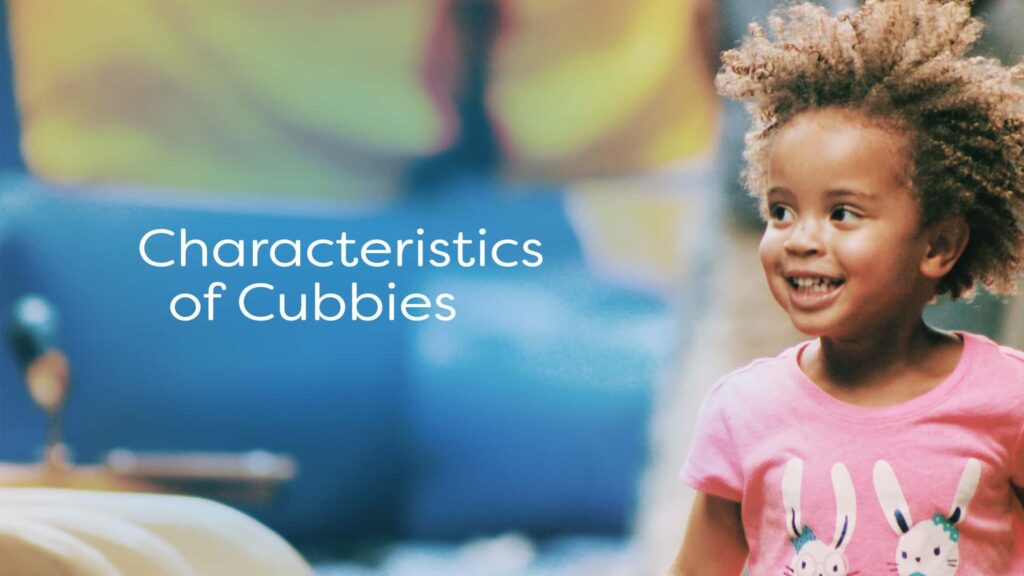Characteristics of Cubbies

Mental Characteristics
Be ready to be amazed! These Cubbies will surprise you with how much they are able to comprehend. Preschoolers have a natural, God-given curiosity, and their little minds are always in high gear, constantly processing information from the world around them. They are tactile learners that love to gain knowledge by touching, tasting and smelling. Your Cubbies will learn best when each of their five senses is incorporated in the educational process. As you are teaching, try to avoid simply talking or reading the lesson to them (most preschoolers can only listen to “teacher talk” for about three to five minutes). Mix up your talking with visuals, movement, drama and other activities to keep Cubbies engaged. (The Cubbies teaching plans lessons are written with this in mind.)
As you prepare your lessons, remember that Cubbies can:
- Follow several commands at one time.
- Solve simple problems and puzzles.
- Grasp early math skills.
- Distinguish letters and numbers.
- Complete simple puzzles.
- Imitate a leader.
- Enjoy imaginary play.
- Understand basic concepts of nature (things are born, grow and die).
- Gain knowledge from all five senses.
- Form very strong opinions of the world around them.
Once you recognize how their little minds best learn, strive to create a safe and fun environment that promotes learning. Preschoolers love structure and familiarity, which is often why they insist on watching their favorite movie or cartoon over and over and OVER. Apply this principle in your classroom by following the same routine each week and repeating key truths often. As you do so, your Cubbies will thrive.
Physical Characteristics
Just as Jesus grew physically from an infant to a man, your Cubbies are gaining strength and mastering new abilities each day.
To help you better understand their level of physical abilities, know that by the time most preschoolers enter your classroom they will be able to:
- Get dressed with little help.
- Skip.
- Hop on one foot.
- Run with ease.
- Walk backwards.
- Bounce a ball.
- Throw a ball several feet.
- Catch a soft ball.
- Ride a tricycle.
- Move hands and feet in rhythm.
- Start cutting and drawing simple shapes and images.
- Manipulate small and large objects.
Each week your Cubbies will be eager to show off a new skill with a confident “Look what I can do” smile. Praise each effort and achievement, and always remember that Cubbies need lots of opportunities to move. Look for ways to incorporate physical action into each activity. Mimic the characters in the Bible lesson; add motions to the Bible verse. Stand and sing a favorite Bible song. By incorporating action you will enhance learning and lessen behavioral distractions.
Emotional and Social Characteristics
Preschoolers are highly emotional. They may enter club clinging tightly to a trusted adult, not willing to let go. Then in a few short moments, they may be running and playing around the room, relishing their new level of independence.
Your Cubbies are also highly social. Even the shyest 3-year-old can interact with others, and many preschoolers can carry on fascinating conversations. Their lives have blossomed to include friendships with those around them, but they are just beginning to recognize how their actions and words evoke both positive and negative responses from others.
In order to help new Cubbies adjust to the club setting, keep in mind that your Cubbies:
- Desire security and continuity.
- Thrive in a structured environment.
- Trust adults willingly.
- Seek to be independent.
- Strive for adult approval.
- Recognize nonverbal cues.
- Develop friendships with peers easily.
- Are very self-centered.
- Become easily frustrated.
- Exhibit fear of certain objects or situations.
Remember, their little minds are working hard to figure out their place in your classroom. As their teacher, you have a responsibility to provide an environment where they can learn to love others and bloom into the unique individuals God wants them to be. Why not encourage Cubbies to share their supplies during Coming In and Handbook Time or to cheer on their teammates during Play Time? By doing so, you are giving these children a practical opportunity to learn to love one another.
Spiritual Characteristics
One glance at the list of emotional and social characteristics above reveals that the sin nature of preschoolers is often on display! And while these little ones will often test every boundary given to them, realize that these learners have receptive hearts.
With the help of each Cubbies lesson (called a Bear Hug) you will take these little minds on a journey to learn these great truths about God over the course of the two-year Cubbies program:
- God is the Creator.
- God is the one true God.
- God’s Word is Truth.
- God keeps His promises.
- God is mighty.
- God is in charge.
- God sent the Savior.
- Jesus is the Good Shepherd.
- Jesus loves all people.
- Jesus says to tell the good news (of the gospel) to others.
Your Cubbies are able to understand and respond to the gospel. At the beginning of each Cubbies club year, the gospel is presented in the entrance booklet (Bear Hugs A and B) and the first two lessons (Bear Hugs 1 and 2). The gospel is constantly retold throughout the lessons in each Cubbies year. Your job is to present the material in a simple, age-appropriate manner. As these precious little ones begin to understand and respect who God is, they will recognize their need for a relationship with Him.
Are you interested in some extra insight into the mental, physical, emotional, and spiritual characteristics of the preschoolers in your Cubbies program? This article is also found on the resource CD of the Cubbies Teaching Plans, but we thought we’d share it here too!
